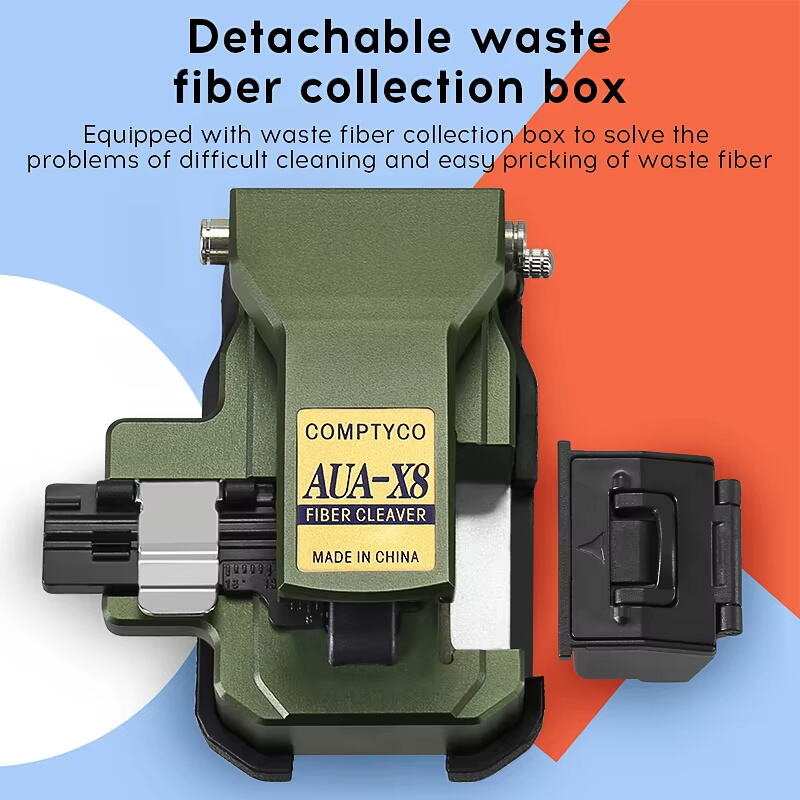What Is a Fiber Cleaver?
Fiber cleavers are basically cutting tools designed specifically for working with optical fibers in fiber optic applications. These devices matter a lot when it comes to making good connections between fibers or doing splices, especially important stuff in telecom networks and all sorts of data communication systems today. What makes them so useful is their ability to create really clean surfaces at the end of those tiny glass fibers. Clean ends mean better light transmission through fusion splices, which translates to stronger signals moving across fiber optic cables without losing strength along the way.
Fiber cleavers do much more than just cut optical cables. When done right, these tools stop signals from getting lost or weakened because they keep the fiber ends clean and smooth during splices. A good cleave makes all the difference for connection quality in fiber optic networks. Think about telecom companies or internet service providers where even small signal drops matter a lot. Without proper cleaving techniques, entire systems can suffer performance issues, which is why professionals spend so much time mastering this skill across different applications.
Most fiber cleavers these days are built from tough materials that can take a lot of wear and tear without losing their edge or effectiveness over time. Better quality units come with features like tension control systems and scribe wheels that make cutting fibers much easier across various sizes. These improvements actually make a big difference in day to day operations, especially as the fiber optic field keeps pushing forward with new standards requiring greater accuracy. Manufacturers keep tweaking both what goes into making them and how they're put together so workers can handle tougher jobs in places where conditions aren't always ideal.
How Does a Fiber Cleaver Work?
The Cleaving Process: Fracture and Tension
Fiber cleaving works based on how materials break when force is applied. To start the process, technicians usually scratch the fiber with something really hard, like a diamond tool, creating a small nick right where they want it to break. Once that mark is there, gentle pressure gets added until the fiber actually snaps along that line, giving a clean cut instead of just chopping it off. Unlike regular scissors or knives, this method gives much better results because the end comes out flat and straight. Getting those ends right matters a lot since bad cuts can mess up signals traveling through the fiber. Networks run smoother when splices work properly, which means fewer problems down the road for anyone relying on high speed internet connections.
Role of Diamond Blades and Precision Alignment
Diamond blades form the heart of nearly all fiber cleavers because they're incredibly hard and precise. When working with optical fibers, these blades make it possible to score the material accurately and create clean cuts without damaging surfaces. This matters a lot since any surface flaws will affect how well the fibers connect together. Getting the alignment right during cutting is just as critical. Even small errors in positioning can ruin a good cleave job and cause problems down the line with signal strength. Recent improvements in tool design have made fiber cleaving much more reliable. Manufacturers now produce equipment that delivers better results consistently, which makes a big difference in telecom networks where connection quality is everything.
Types of Fiber Cleaving Tools
Manual Scribe Cleavers for Basic Applications
For simple optical fiber work that doesn't demand too much precision, manual scribe cleavers remain a go-to option. These tools basically scratch the surface of the fiber by hand, then need some good old fashioned pulling to snap it cleanly. What makes them so popular? Well, they're super simple devices that work great when someone just needs to get the job done without spending a fortune. Most folks find them totally sufficient for those occasional jobs around the shop or lab. But there's definitely a catch here precision isn't their strong suit compared to those fancy automatic models. That's why many weekend warriors and small workshop owners stick with manual cleavers they know what they're getting for their money, even if it means sacrificing a bit of accuracy for everyday tasks.
Precision Fiber Cleavers for Consistent Results
Compared to old school scribe cleavers, precision fiber cleavers consistently produce better quality cuts every time. These modern tools incorporate smart tech that takes over the whole cutting process, which means fewer mistakes from human hands and faster work overall. Their special cutting system keeps signal loss to a minimum, so they're really important in places where accuracy matters most like telecom networks and big data centers. Fiber workers who deal with complex installations day in and day out find these devices much more efficient than trying to get good results with manual methods.

Key Applications of Fiber Cleavers
Fiber Splicing and Fusion Joint Preparation
Fiber cleavers play a vital role during fiber splicing because they produce those clean cuts needed for good fusion and reduced signal loss. The whole process of connecting optical fibers depends on these precision cleaving techniques to get those smooth end surfaces at right angles to the fiber itself. Industry experts point out that when fibers are properly cleaved, there's much less signal degradation, which explains why quality cleaving equipment matters so much. Various types of splicers pair differently with different cleavers depending on what kind of job needs doing, but no matter what combination is used, getting that quality cleave remains essential if we want our fiber networks to operate efficiently without unnecessary losses along the way.
Termination for Connectors and Patch Panels
Fiber cleavers are absolutely necessary when terminating connectors and patch panels if we want our networks to stay connected properly. Getting the cleave right matters because it determines whether fibers will seat correctly in their connectors, which keeps signals strong and prevents those annoying service interruptions everyone hates. Different connector types such as LC versus SC actually need somewhat distinct approaches to cleaving depending on what kind of termination method gets used, so technicians really should know their way around these tools. The level of precision these cleavers offer makes all the difference for long term network reliability, which explains why they show up everywhere from telecom companies to data centers doing fiber optic work.
Choosing the Best Fiber Optical Cleaver
Factors for Precision and Angle Consistency
Choosing the right fiber optical cleaver really comes down to two main things: precision and keeping those angles consistent. The whole point of these tools is to make sure we get clean cuts every time because anything less means signal loss problems down the line. Good quality cleavers come with built-in mechanisms that help keep that cleave angle pretty much exactly at 90 degrees most of the time. Anyone who works with fiber optics knows how critical those angles actually are. Even if something's off by just a fraction, it can mess up data transmission across long distances. Companies such as AFL Fujikura and Sumitomo stand out in this space. Techs working on installation sites tend to gravitate toward these brands since they've proven reliable over years of field testing. People talk about them in workshops all the time when discussing what works best under different conditions.
Durability and Maintenance Requirements
How long a fiber cleaver lasts matters a lot when picking one out. What it's made of and how well constructed determines whether it will stay useful over time. Better quality cleavers tend to have strong metal bodies that hold up against constant handling and still manage to give clean cuts. Keeping these tools working properly requires some basic care routines. Clean the blades regularly and check if the pressure settings need adjusting before each use. Most good cleavers stick around for several years with proper treatment, although actual longevity depends on how much they get used day to day. Taking time for routine maintenance pays off in the end, as it keeps the cleaver performing at its best and ensures reliable results whenever someone needs to work with optical fibers.
FAQ
What is the purpose of a fiber cleaver? A fiber cleaver is used for cutting optical fibers with precision, ensuring a clean optical surface for successful fusion splicing and high-quality signal transmission.
How does a fiber cleaver prevent signal loss? By maintaining the integrity of the optical fibers during cleaving and splicing, fiber cleavers help prevent signal degradation, optimizing connectivity quality.
What are the types of fiber cleaving tools available? There are manual scribe cleavers suitable for basic applications and precision fiber cleavers designed for consistent high-quality results.
How important is the cleaving angle in the quality of fiber connections? The cleaving angle is crucial as deviations can lead to significant data transmission losses, making precision in cleaving essential for optimal performance.







